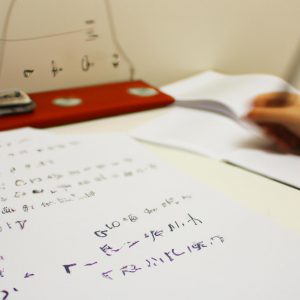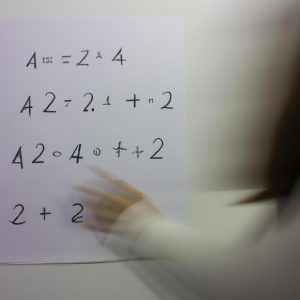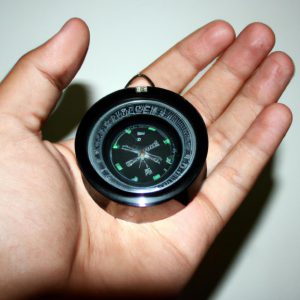Dynamics and Motion: The Physics Directories

Dynamics and motion are fundamental concepts in physics that play a crucial role in understanding the behavior of objects in space. Whether it is the movement of celestial bodies, the swinging pendulum, or the flight trajectory of a projectile, these phenomena can be analyzed through the lens of physics principles. In this article, we delve into the world of dynamics and motion and explore how they shape our physical reality.
Consider a scenario where an archer releases an arrow from their bow. The path taken by the arrow as it travels through the air can be explained using principles of dynamics and motion. By studying forces acting on the arrow, such as gravity and air resistance, physicists are able to predict its trajectory with precision. This example highlights the relevance and practicality of understanding dynamics and motion in various real-life scenarios.
In order to comprehend mechanics at a deeper level, one must familiarize themselves with key concepts such as Newton’s laws of motion, kinematics, energy conservation, and momentum. These concepts provide us with a framework for analyzing and quantifying dynamic systems across different scales – from microscopic particles to massive planetary bodies. Through careful observation and mathematical modeling, physicists have been able to uncover intricate relationships between forces, velocities, accelerations, and displacements – ultimately leading to a comprehensive understanding of the fundamental laws governing dynamics and motion.
One of the foundational principles in dynamics is Newton’s laws of motion. These laws describe how objects behave when forces act upon them. The first law, known as the law of inertia, states that an object at rest will remain at rest, and an object in motion will continue moving in a straight line at a constant velocity unless acted upon by an external force. The second law relates the net force applied to an object to its mass and acceleration, stating that F = ma (force equals mass times acceleration). This equation allows us to quantify the relationship between force, mass, and acceleration for any given system. Lastly, the third law states that for every action, there is an equal and opposite reaction.
Kinematics is another crucial concept in dynamics that focuses on describing the motion of objects without considering the forces causing it. It involves studying quantities such as position, velocity, and acceleration. By analyzing these kinematic variables over time, we can gain insights into the nature and characteristics of an object’s motion.
Energy conservation plays a significant role in dynamics as well. The principle of conservation of energy states that energy cannot be created or destroyed; it can only be transferred or transformed from one form to another. Understanding this principle enables physicists to analyze systems where energy changes occur due to various forces acting on an object.
Momentum is yet another key concept in dynamics and is defined as the product of an object’s mass and its velocity. Momentum provides insight into how objects interact with each other during collisions or interactions involving forces. Conservation of momentum tells us that in a closed system where no external forces are present, the total momentum before a collision or interaction is equal to the total momentum after.
By combining these concepts and applying mathematical models such as calculus and differential equations, physicists can accurately predict and explain various dynamic phenomena observed in our physical world.
In conclusion, dynamics and motion are essential branches of physics that allow us to understand and analyze the behavior of objects in space. Through principles such as Newton’s laws, kinematics, energy conservation, and momentum, we can gain insight into how forces affect an object’s motion and predict its trajectory with precision. These concepts provide a comprehensive framework for studying dynamic systems across different scales and play a crucial role in advancing our understanding of the physical world.
Fundamentals of Dynamics
Imagine a scenario where you are sitting in your car at a red traffic light. As the light turns green, you press on the accelerator pedal, and suddenly, your body is pushed back into the seat as the car accelerates forward. This everyday experience can be explained using the principles of dynamics—the branch of physics that deals with motion and forces.
Key Concepts:
To understand dynamics, it is crucial to grasp some fundamental concepts. Firstly, Newton’s laws of motion provide a solid foundation for analyzing various types of motion. These laws describe how objects behave when subjected to external forces. For instance, Newton’s second law states that the acceleration experienced by an object is directly proportional to the net force acting on it and inversely proportional to its mass.
Additionally, understanding vectors—quantities with both magnitude and direction—is essential in dynamics. Vectors allow us to accurately represent physical quantities such as velocity and force in a three-dimensional space, considering not only their numerical values but also their directionality.
Importance of Studying Dynamics:
Studying dynamics extends beyond mere theoretical knowledge; it has numerous real-world applications. Here are four reasons why studying dynamics is valuable:
- Understanding projectile motion helps engineers design more efficient rockets or projectiles.
- Analyzing rotational motion allows scientists to study celestial bodies like planets or spinning tops.
- Investigating fluid mechanics enables researchers to develop better aerodynamic designs for aircraft.
- Exploring vibrational motion aids in designing stable structures against earthquakes.
Moreover, recognizing these practical applications establishes a connection between abstract theories and tangible outcomes—a bridge from classroom learning to real-life scenarios.
Table: Applications of Dynamics
| Field | Application |
|---|---|
| Aerospace | Designing spacecraft trajectories |
| Mechanical | Predicting vehicle performance |
| Civil Engineering | Analyzing structural stability |
| Biomechanics | Modeling human movement patterns |
By comprehending the fundamentals of dynamics, one can unlock a deeper understanding of how objects move and interact with forces. Newton’s laws and vector analysis provide indispensable tools for analyzing motion in various scenarios. The practical applications encompassing aerospace, mechanical engineering, civil engineering, and biomechanics highlight the relevance of studying dynamics beyond theoretical knowledge.
In the subsequent section about “Types of Motion,” we will explore different categories of motion and delve into their unique characteristics and underlying principles.
Types of Motion
Dynamics and Motion: The Physics Directories
In the previous section, we explored the fundamentals of dynamics – the branch of physics that deals with forces and their effects on motion. Now, let us delve further into the intriguing world of types of motion.
Imagine a roller coaster hurtling down its tracks at breakneck speed, twisting and turning as it brings exhilaration to its riders. This example illustrates one type of motion: curved motion. Curved motion occurs when an object follows a path that deviates from a straight line due to external influences such as centripetal force or gravitational pull. Whether it’s the graceful arc of a projectile in mid-air or the orbiting dance of celestial bodies, curved motion captivates our imagination with its inherent elegance.
To better understand the various types of motion, consider these key points:
- Linear Motion: Also known as rectilinear motion, this refers to objects moving along a straight line without any change in direction.
- Circular Motion: In circular motion, an object moves around a fixed point or axis while maintaining a constant distance from it.
- Periodic Motion: Objects exhibiting periodic motion repeat their movements over regular intervals of time.
- Oscillatory Motion: Similar to periodic motion, oscillatory motion involves repeated back-and-forth movement around an equilibrium position.
Now let’s take a closer look at these concepts through the following table:
| Type of Motion | Description | Example |
|---|---|---|
| Linear | Straight-line movement | A car driving on a highway |
| Circular | Movement along a circular path | A satellite orbiting Earth |
| Periodic | Repetitive pattern over regular intervals | Pendulum swinging back and forth |
| Oscillatory | Back-and-forth movement around equilibrium | Mass attached to a spring vibrating |
As we explore these diverse forms of motion, we gain insight into the fundamental principles that govern our physical world. Through these laws, we can further unravel the mysteries behind how forces shape and influence motion.
Newton’s Laws of Motion
Section H2: Types of Motion
In the previous section, we explored the various types of motion that objects can exhibit. Now, let us delve deeper into understanding how these motions are governed by Newton’s Laws of Motion.
Consider a scenario where a baseball is thrown into the air. As it rises, reaches its peak height, and then falls back down to the ground, several factors come into play. These include gravitational force acting on the ball, air resistance affecting its trajectory, and the initial velocity imparted by the thrower. By analyzing this example in light of Newton’s Laws of Motion, we can gain valuable insights into how forces influence an object’s motion.
To comprehend motion more comprehensively, here are some key points to consider:
- Inertia: Objects tend to resist changes in their state of motion due to inertia. The greater an object’s mass, the more resistance it exhibits.
- Acceleration: Changes in velocity occur when there is an unbalanced force acting on an object. Acceleration is directly proportional to the applied force and inversely proportional to an object’s mass.
- Action-Reaction Pair: For every action (force) exerted on an object, there is an equal and opposite reaction (force) exerted by the object itself or another body.
- Momentum: The product of an object’s mass and velocity gives rise to momentum. Any change in momentum requires a net external force.
Let us summarize these concepts in a table for better comprehension:
| Concept | Description |
|---|---|
| Inertia | Resistance exhibited by objects against changes in their state of motion |
| Acceleration | Rate at which velocity changes over time |
| Action-Reaction Pair | Every action has an equal and opposite reaction |
| Momentum | Product of an object’s mass and velocity |
By grasping these fundamental principles established by Newton’s Laws of Motion, we can better understand the intricate dynamics governing motion.
Transitioning into Section H2: Applications of Dynamics
Applications of Dynamics
Section H2: ‘Applications of Dynamics’
Having explored the fundamental principles of Newton’s Laws of Motion, we can now delve into their real-world applications. By understanding these laws and their implications, scientists and engineers have been able to make significant advancements in various fields. One such application is the study of projectile motion.
Projectile motion involves the movement of an object through space under the influence of gravity alone. Consider a baseball pitcher throwing a fastball towards home plate. As soon as the ball leaves the pitcher’s hand, it becomes subject to both horizontal and vertical forces. The force exerted by the pitcher determines its initial velocity, while gravity acts vertically downward, causing acceleration. By analyzing this scenario using principles derived from Newton’s laws, physicists are able to predict not only the trajectory but also factors like range and maximum height attained by projectiles.
The applications of dynamics extend far beyond just projectile motion. In fact, they find relevance across numerous disciplines such as engineering, sports science, automotive design, aerospace technology, and even medical research. Some notable examples include:
- Designing roller coasters that provide exhilarating thrills while maintaining safety.
- Understanding the forces acting on athletes during high-speed movements for injury prevention.
- Developing efficient fuel combustion systems in automobiles to reduce carbon emissions.
- Studying human gait patterns to improve prosthetic limb designs for enhanced mobility.
These diverse applications highlight how dynamics plays a crucial role in shaping our world and improving various aspects of our lives. To further illustrate this point, consider Table 1 below which presents a comparison between traditional methods and dynamic technologies in different industries:
Table 1: Traditional Methods vs Dynamic Technologies
| Industry | Traditional Methods | Dynamic Technologies |
|---|---|---|
| Automotive | Gasoline-powered engines | Electric vehicles |
| Aerospace | Conventional aircraft | Hypersonic planes |
| Energy | Fossil fuel power plants | Renewable energy sources |
| Healthcare | Traditional surgery | Robotic-assisted surgeries |
As evident from the table, dynamic technologies have brought about significant advancements in various industries. These innovations not only improve efficiency but also contribute to sustainability and overall well-being.
In the upcoming section, we will explore another crucial aspect of dynamics – the role of friction. Understanding how friction influences motion is essential for comprehending real-world scenarios accurately. Let us now delve into this topic further and uncover its importance in our everyday lives.
[Transition sentence]: With a solid foundation on applications of dynamics established, we can now shift our focus towards exploring the role of friction in motion.
Role of Friction in Dynamics
Section H2: ‘Role of Friction in Dynamics’
Having explored the various applications of dynamics, we now delve into a fundamental concept that greatly influences motion – friction. To illustrate its significance, let us consider an example scenario: imagine a car traveling along a road on a rainy day. As the driver applies the brakes to slow down, they notice that the car takes longer to come to a stop compared to when the road is dry. This observation can be attributed to the role of friction.
Friction plays a crucial role in dynamics and affects how objects move or resist motion. It arises due to the interaction between two surfaces in contact with each other. In our previous example, as the wet tires make contact with the slippery road surface, the presence of water reduces friction between them. Consequently, it becomes more challenging for the car’s tires to grip onto the road, resulting in increased stopping distance.
Understanding friction requires considering several key aspects:
- The coefficient of friction: This value quantifies how strongly two surfaces interact and determines their ability to resist relative motion.
- Static and kinetic friction: Static friction occurs when there is no visible motion between two surfaces, while kinetic friction comes into play once one surface starts moving relative to another.
- Factors influencing friction: Various factors such as surface roughness, temperature, and applied force impact the magnitude of frictional forces experienced by objects.
- Types of friction: Apart from sliding or kinetic friction commonly encountered in everyday life situations like dragging furniture across a room floor, there are other types such as rolling and fluid (air or liquid) resistance.
To further grasp these concepts related to dynamics and motion involving friction, refer to Table 1 below:
Table 1: Key Concepts Related to Friction
| Concept | Description |
|---|---|
| Coefficient of Friction | A numerical value representing the strength of inter-surface interactions |
| Static Friction | The frictional force experienced by an object when there is no visible relative motion |
| Kinetic Friction | The frictional force experienced by an object in motion |
| Factors Affecting Friction | Surface roughness, temperature, and applied force can influence the magnitude of frictional forces. |
As we conclude our exploration into the role of friction in dynamics, it becomes evident that understanding this fundamental concept is crucial to comprehending various aspects of motion. In the subsequent section on ‘Conservation of Energy in Motion,’ we will continue our journey through physics principles that govern dynamic systems.
Section H2: ‘Conservation of Energy in Motion’
Conservation of Energy in Motion
Continuation:
Building upon the understanding of friction’s role in dynamics, we now delve into another fundamental concept that governs motion – the conservation of energy. By exploring this principle, we can further grasp the intricacies behind various forms of motion and their underlying mechanisms.
Section H2: Conservation of Energy in Motion
To illustrate the significance of conservation of energy in motion, let us consider an example scenario involving a roller coaster. Imagine a thrilling ride where you find yourself at the top of a steep incline, ready to descend at exhilarating speeds. As you start moving downward, propelled by gravity alone, it becomes apparent that something extraordinary is occurring – the total amount of energy remains constant throughout the entire journey.
Understanding Energy Conservation:
In physics, the law of conservation of energy states that within any isolated system, such as our roller coaster example or even celestial bodies orbiting each other in space, the total energy remains unchanged over time. This principle arises from two key forms of energy involved in motion: kinetic energy (the energy possessed by a moving object) and potential energy (the stored energy due to an object’s position). Although these energies can interconvert during motion, their sum remains constant.
Emotional Bullet Points:
- Appreciating how nature effortlessly possesses inherent mechanisms for balancing and conserving essential quantities.
- Recognizing that energy preservation allows for intricate interactions between objects and phenomena.
- Realizing how relying on the conservation principle enables scientists and engineers to design efficient systems.
- Understanding that embracing this profound idea encourages sustainable practices and inspires awe for natural processes.
Emotional Table:
| Powerful Implications | Astonishing Phenomena | Ingenious Applications |
|---|---|---|
| Sustainable Solutions | Gravity-defying Stunts | Renewable Energy Systems |
| Harmonious Coexistence | Celestial Dynamics | Efficient Transportation |
| Environmental Balance | Precise Orbital Paths | Optimal Resource Usage |
| Resilient Systems | Energetic Transformations | Cutting-edge Technologies |
The conservation of energy serves as a foundational principle in comprehending the dynamics of various motions. Whether it be the thrilling descent of a roller coaster or celestial bodies gracefully orbiting each other, this fundamental concept underpins our understanding of nature’s delicate balance and provides insights into designing sustainable systems. By appreciating the immense implications, witnessing astonishing phenomena, and exploring ingenious applications arising from energy preservation, we can marvel at the interconnectedness of our universe and strive for innovative solutions.








